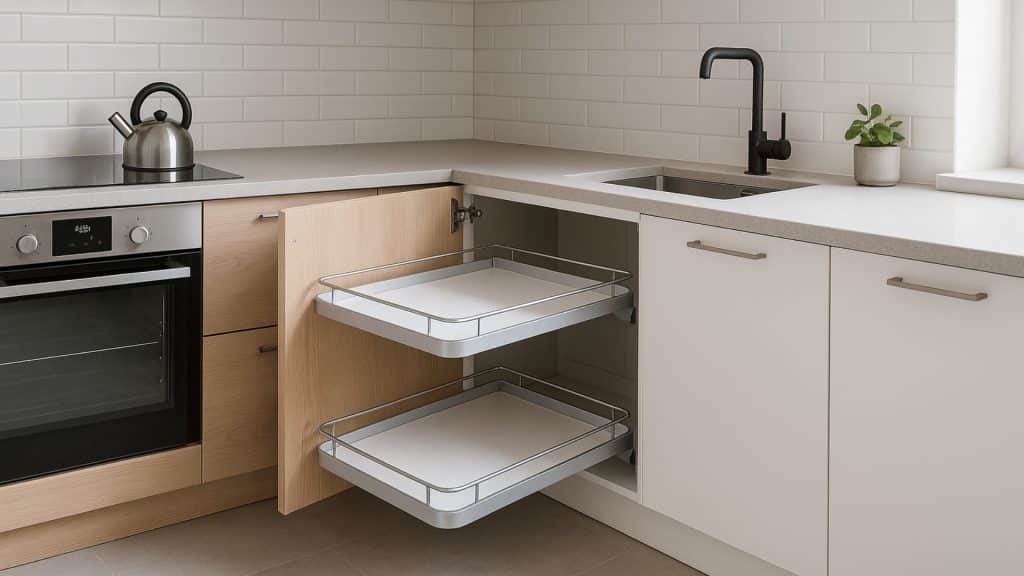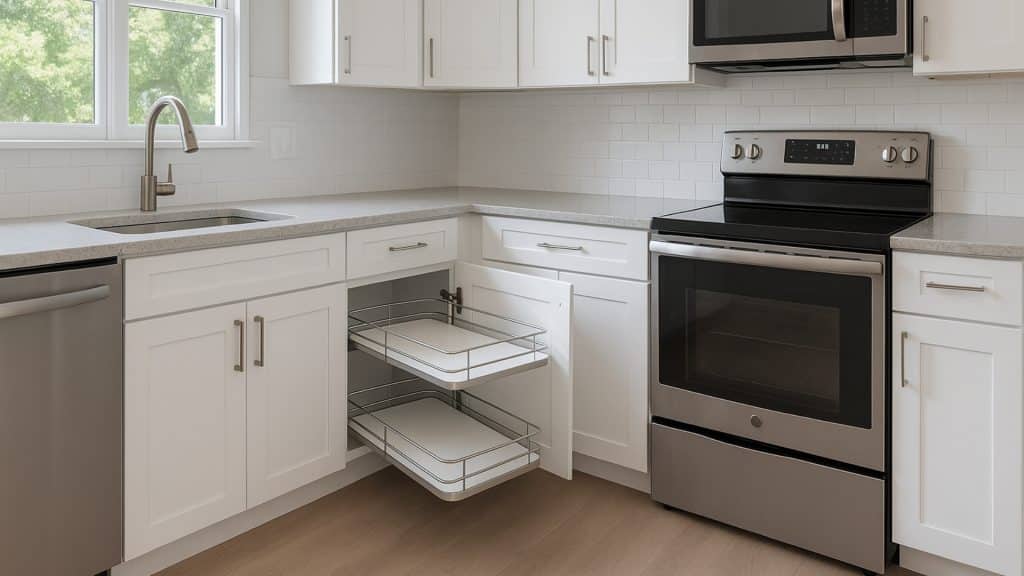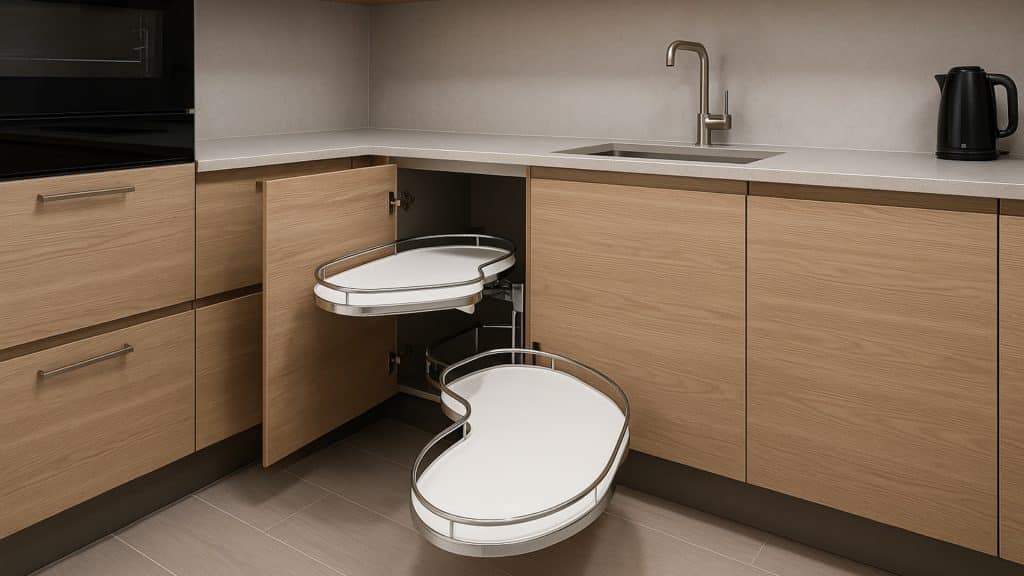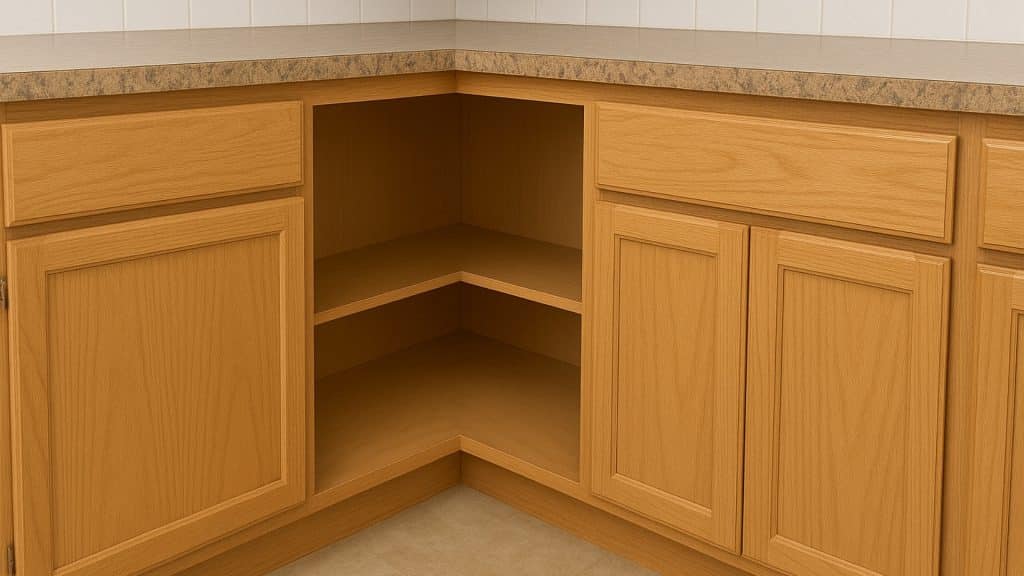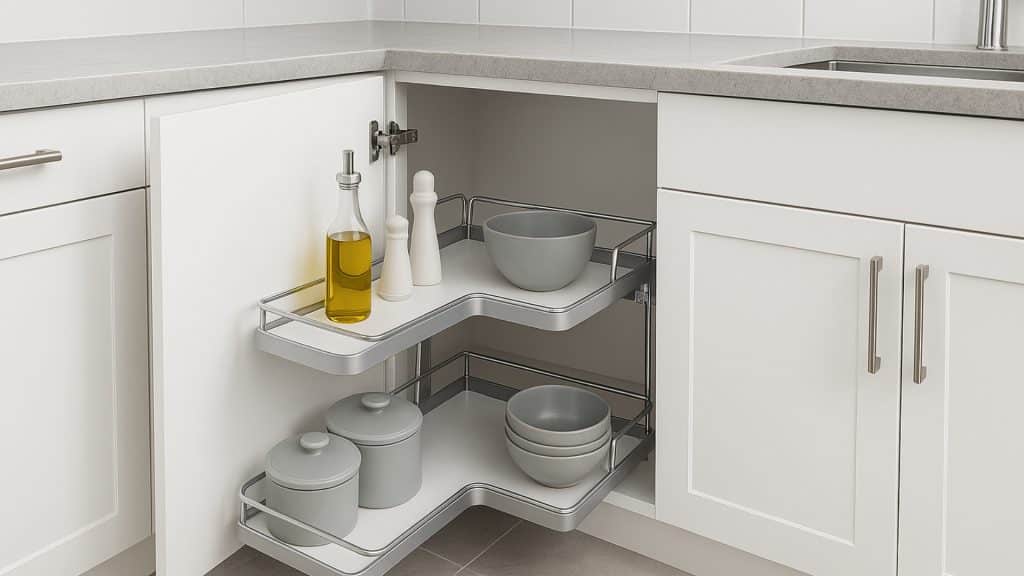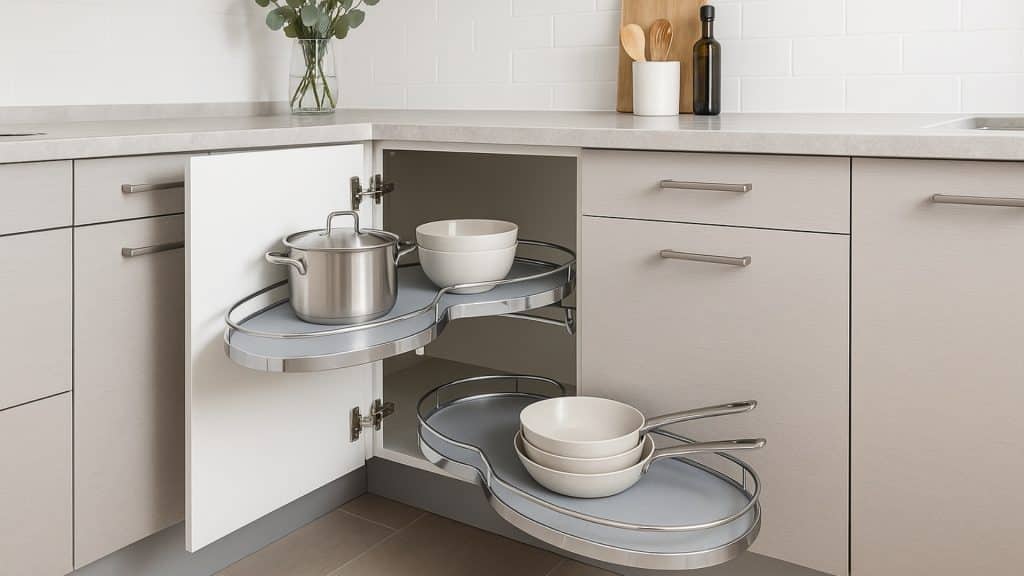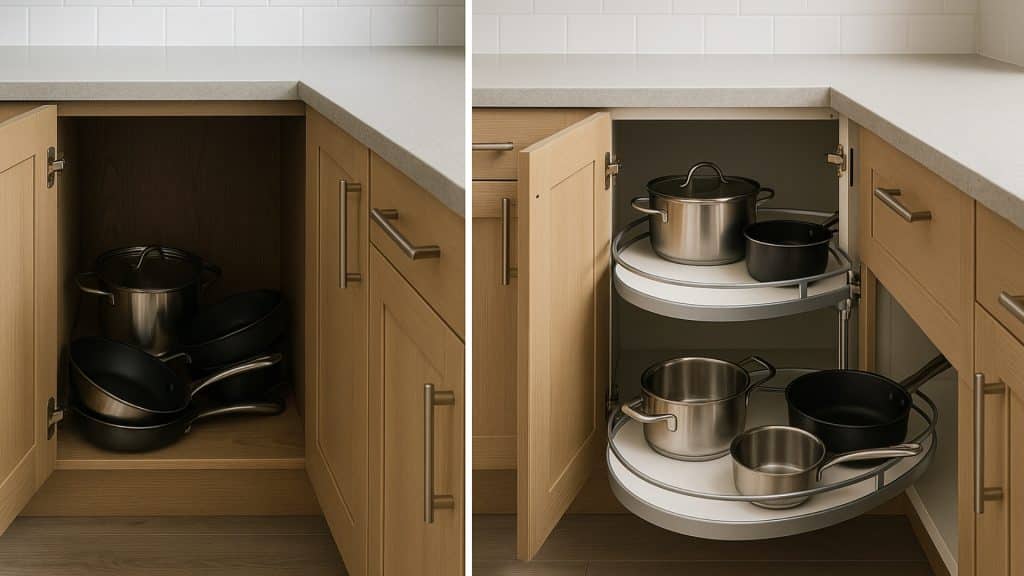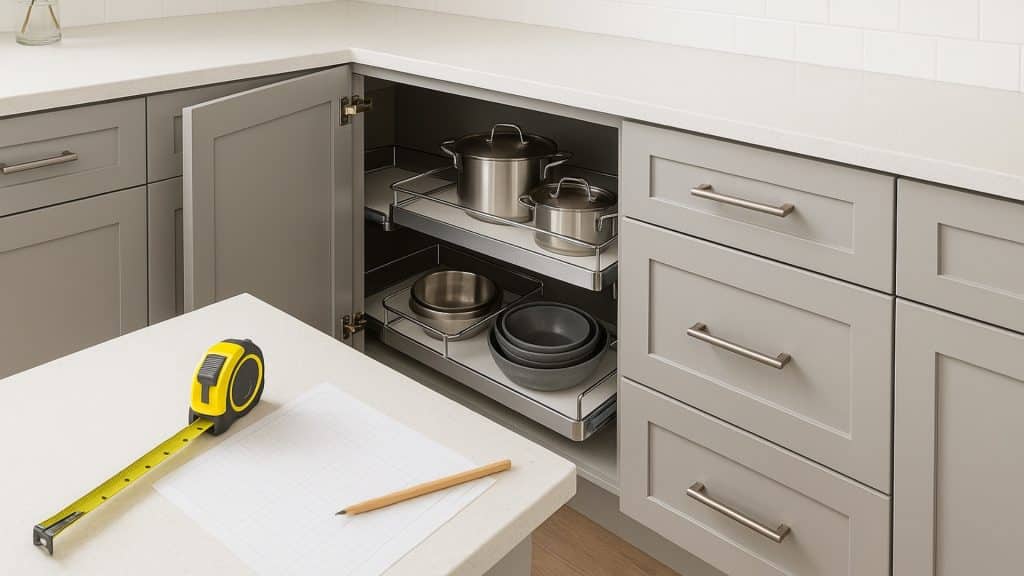Have you ever opened a kitchen cabinet and realized there’s a big, awkward space in the corner that’s hard to use?
That’s where a blind corner cabinet comes in.
But what is a blind corner cabinet, exactly?
It’s a special type of cabinet designed to make use of the hidden space where two walls meet in an L-shaped kitchen layout.
Without it, that corner often becomes dead space or hard to reach.
We’ll explain what blind corner cabinets are, the different types available, and how to choose the right one for your needs.
If you’re building a new kitchen or upgrading an old one, learning about blind corner cabinets can help you make smarter design choices and avoid wasted space.
What is a Blind Corner Cabinet?
A blind corner cabinet is a kitchen storage solution found where two perpendicular cabinet runs meet at a corner.
What makes these cabinets unique is that a portion of the storage space extends deep into the corner, creating an area that’s difficult to see and reach.
When you open the cabinet door, you can only access what’s immediately visible – the rest remains “blind” or hidden from view.
This design evolved as a practical way to utilize otherwise wasted corner space in kitchens.
Without special hardware, items stored in the back often become forgotten or inaccessible, creating what many homeowners call the “black hole” of kitchen storage.
Despite this challenge, blind corner cabinets maximize storage potential in kitchens where space efficiency is crucial, particularly in smaller homes or apartments where every inch of storage matters.
Where Are Blind Corner Cabinets Used?
Blind corner cabinets are most commonly found in L-shaped and U-shaped kitchen layouts where two cabinet runs meet at right angles.
These kitchen designs naturally create corners that would otherwise become dead space without specialized storage solutions.
Designers often install blind corner cabinets in kitchens where the corner space is too irregular or constrained for alternatives like diagonal corner cabinets or full corner Lazy Susans.
You’ll frequently see these in apartments, condos, and older homes where maximizing every inch of storage is essential.
While primarily used in kitchens, blind corner cabinets occasionally appear in bathroom vanities, laundry rooms, or home offices with similar corner configurations.
Blind corner solutions are ideal for awkward corner spaces when budget and space constraints make other options impractical.
How Blind Corner Cabinets Work
Blind corner cabinets typically feature a standard cabinet door that opens to reveal only the front portion of the cabinet.
Behind this visible area, additional storage space extends deep into the corner, hidden from direct view.
Without special hardware, this creates a problem – items stored in the back become difficult or impossible to reach without crawling halfway into the cabinet.
Fortunately, modern cabinet manufacturers have developed clever solutions to make these spaces more functional.
Pull-out trays slide forward to bring hidden items into reach, while swing-out shelving systems pivot from inside the cabinet to bring corner contents completely into view.
Some advanced mechanisms combine both motions, first pulling forward, then swinging out to maximize accessibility.
Wire baskets, chrome shelving units, and wooden trays are common features of these systems, each designed to change the problematic blind corner into practical, usable storage space.
Types of Blind Corner Cabinets
Blind corner cabinets come in a few different types, and each one has its own pros and cons.
Some are simple and cost less, while others offer better access but cost more.
The right choice depends on your budget, kitchen space, and how often you use your cabinet storage.
1. Standard Blind Cabinets
Standard blind corner cabinets are the most basic and affordable option.
They have a large, hidden space that’s hard to reach. You usually need to bend and reach deep inside to get things out.
These cabinets don’t come with special hardware or shelves, which keeps the price low.
But they’re not very user-friendly.
If you store things here, they might get lost or forgotten because they’re so hard to access.
TypicalCost Range – $260 – $320
2. Pull-Out or Sliding Blind Corner Systems
Pull-out or sliding blind corner systems are much easier to use than standard cabinets.
These systems have shelves or trays that slide out when you open the cabinet door.
This lets you reach items in the back without digging around.
They’re great for everyday use and make full use of the space.
However, they do cost more than standard cabinets because of the added hardware and design.
TypicalCost Range – $640 – $1,200
3. Swing-Out (le Mans) Shelves
Swing-out shelves, often called le mans shelves, are one of the best options for blind corners.
The shelves are shaped like a kidney bean and swing out of the cabinet when you open the door.
This gives you quick and full access to everything inside.
These shelves are very convenient and look modern, but they are also the most expensive option.
If you want ease of use and don’t mind spending more, this is a great choice.
TypicalCost Range – $570 – $1,210
Pros and Cons of Blind Corner Cabinets
Blind corner cabinets have some great benefits, but they also come with a few downsides.
Before choosing one, it helps to understand both the good and the bad so you can decide what works best for your kitchen.
Pros
Blind corner cabinets are a smart way to make use of space that would otherwise go to waste.
These cabinets fit into tight corners, providing hidden storage that helps keep your countertops free of clutter.
They’re perfect for storing larger kitchen items like pots, pans, or small appliances.
Over time, you can upgrade them by adding pull-out trays, shelves, or organizers, which makes them more functional.
Even basic models can become highly efficient with the right accessories, making them a flexible choice for long-term kitchen use.
Cons
While blind corner cabinets offer hidden storage, they can be harder to use than other corner solutions like lazy susans or corner drawers.
You often have to reach deep inside to grab items, which isn’t ideal for everyday use.
Installing them can also be a challenge, especially in tight kitchens or during renovations.
To make them more user-friendly, you may need custom shelving or special pull-out hardware, which adds to both the cost and complexity.
This makes them less convenient if you’re on a tight budget or timeline.
Tips for Choosing or Upgrading a Blind Corner Cabinet
Picking the right blind corner cabinet can make your kitchen more organized and easier to use.
If you’re choosing a new one or upgrading an old cabinet, a few smart choices can go a long way.
Here are some helpful tips to keep in mind:
- Measure your space to make sure the cabinet fits your kitchen layout.
- Choose a cabinet that matches your kitchen’s style and size.
- Look for soft-close hinges or sliding shelves for easier access.
- Think about what you’ll store — heavy items need strong shelves.
- Add pull-out trays or swing-out shelves to make things easier to reach.
- Make sure the cabinet opens the right way for your kitchen setup.
These simple tips can help you get the most out of your blind corner cabinet.
With a little planning, you can turn a hard-to-reach space into one of the most useful spots in your kitchen.
The Bottom Line
Now that you understand what a blind corner cabinet is and how it works, you can see how valuable it can be in your kitchen design.
While it may not be the easiest cabinet to access, the right accessories and layout can make it both useful and efficient.
From basic models to advanced pull-out or swing-out systems, blind corner cabinets offer flexible options for all types of kitchens.
They’re especially helpful in small spaces where every inch counts.
Just remember to consider your storage needs, kitchen layout, and budget before making a choice.
With the right setup, a blind corner cabinet can turn a once-wasted area into one of the most helpful spots in your kitchen.

